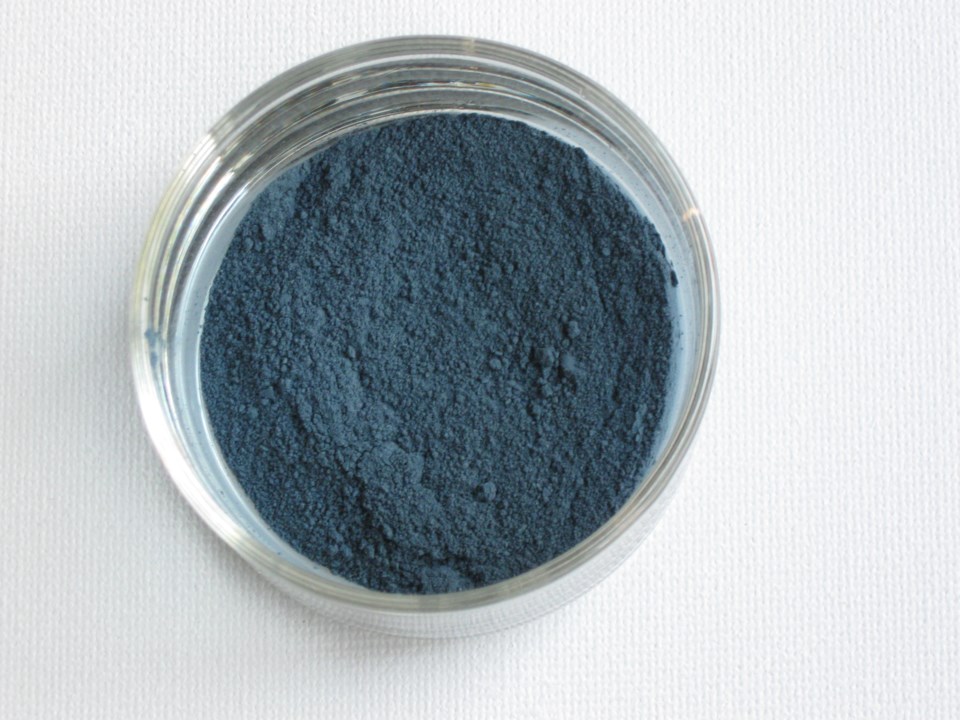My fascination with blue is linked to my fascination with herbs. Both began at the same time in the same place. While living in Italy, I often drove from Florence, east across the Apennines, to what was once the Duchy of Urbino, located in the region known as The Marches. Nestling in the Apennine foothills on the eastern side is a village, Lamoli, the site of an ancient Benedictine Abbey, rebuilt in the 12th century, which in our day hosted a restaurant as well as a museum of natural colours. The food and wine in the restaurant were all local, and the colours in the museum, intended mostly as dyes for textiles, were derived from local plants. Time seemed to have stood still for a few hundred years in that former Benedictine Abbey.
The blue pigment I saw in the museum came from the leaves of the woad plant (Isatis tinctoria), which had been an important crop in the area because of its use as a dye. Woad is one of the many plants considered a herb, and from the day I visited the museum of natural colours, I was determined to grow it, together with as many other herbs as I could accumulate and accommodate.
Woad was cultivated throughout Europe for its economic importance, which went unchallenged until the 16th century when trade routes were established with India, where another blue-dye-producing plant grew – indigo (Indigofera tinctoria), which gave a more intense blue that was also lightfast.
Associating the colour blue with outstanding qualities is believed to have originated in France in the late 16th century. The story goes like this. On 31 December 1578 King Henri III instituted the chivalric Order of the Holy Spirit, whose members wore a blue ribbon from which hung their badge, the Maltese cross adorned with a white dove descending. Because of the blue ribbon, the knights became known as “Les Cordons Bleus”. Legend has it that the banquets following their ceremonies were so lavish that the words “cordon bleu” became a synonym for cooking of extraordinarily high quality.
Eventually the blue ribbon honour was extended to exceptional achievements in a variety of fields, especially in connection with sporting events – for instance, the Blue of Cambridge or Oxford, awarded to someone competing at the highest level in a university sport such as rowing or cricket. Another accomplishment distinguished by the colour blue was the Blue Riband of the Atlantic, a rank assigned to the transatlantic passenger liner in regular service with the fastest average speed. The competition began in the 19th century and continued until air travel had surpassed sea voyages in popularity.
Starting in the early 19th century, the English aristocracy was often described as having blue blood. Before a deep tan became a status symbol in the second half of the 20th century, the upper classes avoided the sun, unlike the lower classes who often had to labour in the fields. The pale skin of the aristocracy allowed the blueness of their blood vessels to show through.
Were you stargazing the night of 22 August 2021? If so, you will have seen a Blue Moon. But was it really blue? Well, a blue moon is such a rare event that it comes along only once in a blue moon. It happened in Indonesia in 1883, when the eruption of the volcano Krakatoa sent ash particles into the air that filtered red light and turned the moon blue. It happened again in 1983, with El Chichon in Mexico; in 1980 with Mt. St. Helens; and in 1991 with Mount Pinatubo.
Watch the sky the night of 30 August 2023 for the next Blue Moon! Perhaps that Blue Moon will be one of those exceptional ones that occur but once in a blue moon.
Sabine Eiche is a local writer and art historian with a PhD from Princeton University. She is passionately involved in preserving the environment and protecting nature. Her columns deal with a broad range of topics and often include the history (etymology) of words in order to shed extra light on the subject.



